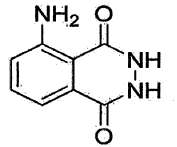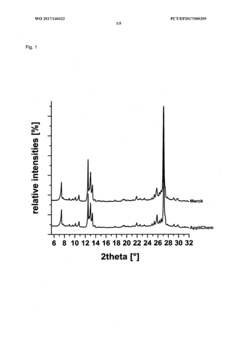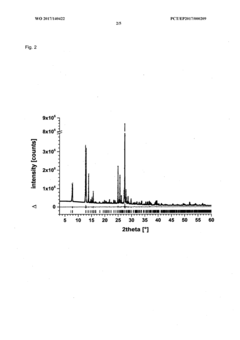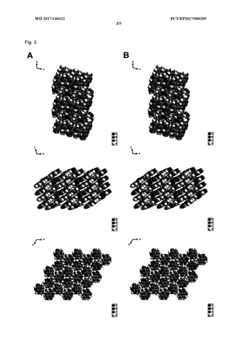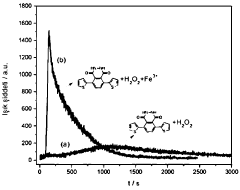Luminol's Impact on Eco-Friendly Research Practices
AUG 19, 20259 MIN READ
Generate Your Research Report Instantly with AI Agent
Patsnap Eureka helps you evaluate technical feasibility & market potential.
Luminol Research Goals
Luminol, a chemiluminescent compound, has long been a staple in forensic science and biochemical research. However, its potential impact on eco-friendly research practices has recently garnered significant attention. The primary goal of luminol research in this context is to explore and develop sustainable applications that leverage its unique properties while minimizing environmental impact.
One key objective is to optimize luminol synthesis processes to reduce the use of harmful chemicals and energy consumption. This involves investigating green chemistry approaches, such as using renewable resources as starting materials and employing catalysts that facilitate more efficient reactions. Researchers aim to develop environmentally benign production methods that maintain or enhance luminol's performance characteristics.
Another crucial research goal is to expand luminol's applications in environmental monitoring and remediation. Scientists are exploring its potential for detecting and quantifying pollutants in water and soil, particularly heavy metals and organic contaminants. The development of luminol-based sensors that are both sensitive and eco-friendly could revolutionize environmental testing procedures, making them more accessible and sustainable.
Improving the biodegradability of luminol and its derivatives is also a priority. Current research focuses on modifying the molecular structure to enhance its susceptibility to natural breakdown processes without compromising its chemiluminescent properties. This could significantly reduce the environmental persistence of luminol-based products and their potential long-term ecological impacts.
Researchers are also investigating the integration of luminol into sustainable energy systems. The compound's ability to generate light through chemical reactions has sparked interest in its potential use in bioluminescent technologies for low-energy lighting solutions. This could lead to the development of eco-friendly alternatives to traditional lighting methods, particularly in remote or resource-limited areas.
Furthermore, there is a growing emphasis on exploring luminol's role in green analytical chemistry. Scientists are working to develop luminol-based analytical techniques that require smaller sample sizes, generate less waste, and consume less energy compared to conventional methods. This aligns with the principles of green chemistry and contributes to more sustainable laboratory practices.
Lastly, researchers are investigating the potential of luminol in bioremediation processes. Studies are underway to determine if luminol can enhance the activity of certain microorganisms used in the breakdown of environmental pollutants. If successful, this could lead to more efficient and eco-friendly methods for cleaning up contaminated sites.
One key objective is to optimize luminol synthesis processes to reduce the use of harmful chemicals and energy consumption. This involves investigating green chemistry approaches, such as using renewable resources as starting materials and employing catalysts that facilitate more efficient reactions. Researchers aim to develop environmentally benign production methods that maintain or enhance luminol's performance characteristics.
Another crucial research goal is to expand luminol's applications in environmental monitoring and remediation. Scientists are exploring its potential for detecting and quantifying pollutants in water and soil, particularly heavy metals and organic contaminants. The development of luminol-based sensors that are both sensitive and eco-friendly could revolutionize environmental testing procedures, making them more accessible and sustainable.
Improving the biodegradability of luminol and its derivatives is also a priority. Current research focuses on modifying the molecular structure to enhance its susceptibility to natural breakdown processes without compromising its chemiluminescent properties. This could significantly reduce the environmental persistence of luminol-based products and their potential long-term ecological impacts.
Researchers are also investigating the integration of luminol into sustainable energy systems. The compound's ability to generate light through chemical reactions has sparked interest in its potential use in bioluminescent technologies for low-energy lighting solutions. This could lead to the development of eco-friendly alternatives to traditional lighting methods, particularly in remote or resource-limited areas.
Furthermore, there is a growing emphasis on exploring luminol's role in green analytical chemistry. Scientists are working to develop luminol-based analytical techniques that require smaller sample sizes, generate less waste, and consume less energy compared to conventional methods. This aligns with the principles of green chemistry and contributes to more sustainable laboratory practices.
Lastly, researchers are investigating the potential of luminol in bioremediation processes. Studies are underway to determine if luminol can enhance the activity of certain microorganisms used in the breakdown of environmental pollutants. If successful, this could lead to more efficient and eco-friendly methods for cleaning up contaminated sites.
Green Chemistry Demand
The demand for green chemistry practices has been steadily increasing in recent years, driven by growing environmental concerns and the need for sustainable research methods. Luminol, a chemiluminescent compound widely used in forensic science and biochemistry, has emerged as a key player in this shift towards eco-friendly research practices.
The market for green chemistry solutions is expanding rapidly, with a particular focus on reducing the environmental impact of laboratory processes. Researchers and institutions are actively seeking alternatives to traditional chemical reagents that are less toxic, more energy-efficient, and produce fewer waste products. Luminol's unique properties make it an attractive option for addressing these concerns in various scientific disciplines.
In forensic science, the demand for luminol-based detection methods has grown significantly. Law enforcement agencies and crime scene investigators are increasingly adopting luminol as a non-toxic alternative to traditional blood detection techniques. This shift is driven by the need for safer working conditions and reduced environmental contamination at crime scenes.
The biochemistry and molecular biology sectors have also shown a rising interest in luminol-based assays. As research institutions strive to minimize their ecological footprint, there is a growing demand for luminol-enhanced chemiluminescence techniques in protein and enzyme studies. These methods offer high sensitivity while reducing the use of radioactive materials and hazardous chemicals commonly employed in traditional assays.
Environmental monitoring is another area where the demand for luminol-based technologies is increasing. Water quality testing, pollution detection, and ecological studies are benefiting from luminol's ability to detect trace amounts of certain compounds with minimal environmental impact. This aligns with the broader trend of developing green analytical methods for environmental assessment.
The pharmaceutical industry is also contributing to the growing demand for luminol in eco-friendly research practices. Drug discovery and development processes are being reevaluated to incorporate more sustainable methods. Luminol-based high-throughput screening assays are gaining popularity as they offer a balance between sensitivity and environmental responsibility.
Academic institutions and research laboratories are increasingly prioritizing green chemistry principles in their operations. This has led to a surge in demand for luminol and related compounds in educational settings, where they are used to demonstrate eco-friendly chemical reactions and analytical techniques to students.
As regulations around chemical use and disposal become more stringent, industries are proactively seeking greener alternatives. Luminol's biodegradability and low toxicity make it an attractive option for companies looking to comply with environmental regulations while maintaining high standards of research and development.
The global push towards sustainable development goals has further amplified the demand for green chemistry solutions like luminol. Governments and international organizations are investing in research and development of eco-friendly scientific practices, creating new opportunities for luminol applications in various fields.
The market for green chemistry solutions is expanding rapidly, with a particular focus on reducing the environmental impact of laboratory processes. Researchers and institutions are actively seeking alternatives to traditional chemical reagents that are less toxic, more energy-efficient, and produce fewer waste products. Luminol's unique properties make it an attractive option for addressing these concerns in various scientific disciplines.
In forensic science, the demand for luminol-based detection methods has grown significantly. Law enforcement agencies and crime scene investigators are increasingly adopting luminol as a non-toxic alternative to traditional blood detection techniques. This shift is driven by the need for safer working conditions and reduced environmental contamination at crime scenes.
The biochemistry and molecular biology sectors have also shown a rising interest in luminol-based assays. As research institutions strive to minimize their ecological footprint, there is a growing demand for luminol-enhanced chemiluminescence techniques in protein and enzyme studies. These methods offer high sensitivity while reducing the use of radioactive materials and hazardous chemicals commonly employed in traditional assays.
Environmental monitoring is another area where the demand for luminol-based technologies is increasing. Water quality testing, pollution detection, and ecological studies are benefiting from luminol's ability to detect trace amounts of certain compounds with minimal environmental impact. This aligns with the broader trend of developing green analytical methods for environmental assessment.
The pharmaceutical industry is also contributing to the growing demand for luminol in eco-friendly research practices. Drug discovery and development processes are being reevaluated to incorporate more sustainable methods. Luminol-based high-throughput screening assays are gaining popularity as they offer a balance between sensitivity and environmental responsibility.
Academic institutions and research laboratories are increasingly prioritizing green chemistry principles in their operations. This has led to a surge in demand for luminol and related compounds in educational settings, where they are used to demonstrate eco-friendly chemical reactions and analytical techniques to students.
As regulations around chemical use and disposal become more stringent, industries are proactively seeking greener alternatives. Luminol's biodegradability and low toxicity make it an attractive option for companies looking to comply with environmental regulations while maintaining high standards of research and development.
The global push towards sustainable development goals has further amplified the demand for green chemistry solutions like luminol. Governments and international organizations are investing in research and development of eco-friendly scientific practices, creating new opportunities for luminol applications in various fields.
Luminol Eco-Challenges
Luminol, while a powerful tool in forensic science and research, presents several ecological challenges that need to be addressed for more sustainable practices. One of the primary concerns is its potential toxicity to aquatic ecosystems. When luminol solutions are disposed of improperly, they can contaminate water sources, affecting marine life and potentially entering the food chain. This raises significant environmental concerns, particularly in areas where forensic investigations or research activities are frequent.
Another eco-challenge associated with luminol is its production process. The synthesis of luminol involves the use of various chemicals, some of which may have harmful environmental impacts. The manufacturing of luminol and its precursors can contribute to industrial pollution if not properly managed. This includes air emissions, water pollution, and the generation of hazardous waste. As environmental regulations become more stringent, there is a growing need to develop greener synthesis methods for luminol and related compounds.
The disposal of luminol-treated materials also presents ecological challenges. In forensic applications, items treated with luminol may require special handling and disposal procedures to prevent environmental contamination. This includes clothing, furniture, and other objects that have been sprayed with luminol solution during investigations. Improper disposal can lead to soil contamination and potential leaching into groundwater systems.
Furthermore, the use of luminol in large-scale applications, such as crime scene investigations or extensive research projects, can result in significant chemical waste. This waste, if not properly managed, can accumulate and pose long-term environmental risks. The challenge lies in developing effective waste management protocols that minimize the environmental footprint of luminol use while maintaining its efficacy in research and forensic applications.
There is also growing concern about the potential for luminol to interfere with natural bioluminescent processes in the environment. While the direct impact is not fully understood, there is a possibility that the release of luminol into natural ecosystems could disrupt the signaling mechanisms of bioluminescent organisms, affecting their behavior and ecological roles.
To address these eco-challenges, researchers and forensic professionals are exploring alternative formulations and application methods. This includes the development of more biodegradable versions of luminol, as well as techniques that require smaller quantities of the chemical. Additionally, there is a push towards more efficient recovery and recycling methods for luminol solutions, aiming to reduce overall waste and environmental impact.
Another eco-challenge associated with luminol is its production process. The synthesis of luminol involves the use of various chemicals, some of which may have harmful environmental impacts. The manufacturing of luminol and its precursors can contribute to industrial pollution if not properly managed. This includes air emissions, water pollution, and the generation of hazardous waste. As environmental regulations become more stringent, there is a growing need to develop greener synthesis methods for luminol and related compounds.
The disposal of luminol-treated materials also presents ecological challenges. In forensic applications, items treated with luminol may require special handling and disposal procedures to prevent environmental contamination. This includes clothing, furniture, and other objects that have been sprayed with luminol solution during investigations. Improper disposal can lead to soil contamination and potential leaching into groundwater systems.
Furthermore, the use of luminol in large-scale applications, such as crime scene investigations or extensive research projects, can result in significant chemical waste. This waste, if not properly managed, can accumulate and pose long-term environmental risks. The challenge lies in developing effective waste management protocols that minimize the environmental footprint of luminol use while maintaining its efficacy in research and forensic applications.
There is also growing concern about the potential for luminol to interfere with natural bioluminescent processes in the environment. While the direct impact is not fully understood, there is a possibility that the release of luminol into natural ecosystems could disrupt the signaling mechanisms of bioluminescent organisms, affecting their behavior and ecological roles.
To address these eco-challenges, researchers and forensic professionals are exploring alternative formulations and application methods. This includes the development of more biodegradable versions of luminol, as well as techniques that require smaller quantities of the chemical. Additionally, there is a push towards more efficient recovery and recycling methods for luminol solutions, aiming to reduce overall waste and environmental impact.
Eco-Friendly Solutions
01 Luminol in forensic applications
Luminol is widely used in forensic science for detecting trace amounts of blood at crime scenes. When luminol comes into contact with the iron in hemoglobin, it produces a bright blue chemiluminescence. This reaction can reveal blood traces that are invisible to the naked eye, even if the area has been cleaned.- Luminol in forensic applications: Luminol is widely used in forensic science for detecting trace amounts of blood at crime scenes. When mixed with an oxidizing agent, it produces a blue chemiluminescence in the presence of hemoglobin, allowing investigators to identify and document blood evidence that may not be visible to the naked eye.
- Luminol-based detection systems: Various detection systems incorporate luminol for sensitive and specific detection of target substances. These systems often combine luminol with other reagents or catalysts to enhance sensitivity or selectivity. Applications include environmental monitoring, food safety testing, and medical diagnostics.
- Luminol synthesis and formulation: Improved methods for synthesizing and formulating luminol have been developed to enhance its performance and stability. These advancements include novel synthetic routes, purification techniques, and formulation strategies to optimize luminol's chemiluminescent properties for various applications.
- Luminol in analytical chemistry: Luminol plays a crucial role in analytical chemistry, particularly in flow injection analysis and high-performance liquid chromatography. Its chemiluminescent properties enable highly sensitive detection of various analytes, including metal ions, organic compounds, and biomolecules.
- Luminol-based imaging techniques: Advanced imaging techniques utilizing luminol have been developed for various applications. These include enhanced visualization of latent fingerprints, detection of specific cellular processes in biological research, and non-invasive imaging of physiological events in living organisms.
02 Luminol-based detection systems
Various detection systems incorporate luminol for its chemiluminescent properties. These systems are used in environmental monitoring, food safety testing, and medical diagnostics. The high sensitivity of luminol allows for the detection of minute quantities of target substances, making it valuable in analytical chemistry and biosensing applications.Expand Specific Solutions03 Luminol synthesis and modifications
Research focuses on improving luminol synthesis methods and developing modified versions with enhanced properties. These efforts aim to increase luminol's sensitivity, stability, and specificity for various applications. Modified luminol compounds may exhibit stronger luminescence, longer-lasting glow, or improved selectivity for certain analytes.Expand Specific Solutions04 Luminol in biomedical research
Luminol finds applications in biomedical research, particularly in studying cellular processes involving reactive oxygen species. It is used to detect and quantify the production of hydrogen peroxide and other oxidants in biological systems. This application aids in understanding oxidative stress, inflammation, and immune responses at the cellular level.Expand Specific Solutions05 Luminol-based imaging techniques
Advanced imaging techniques utilize luminol's chemiluminescent properties for visualization in various fields. These include bioluminescence imaging in live animals, visualization of latent fingerprints in forensics, and mapping of oxidative processes in plants. The non-invasive nature of luminol-based imaging makes it valuable for in vivo studies and non-destructive testing.Expand Specific Solutions
Key Luminol Players
The luminol research landscape is evolving rapidly, with increasing focus on eco-friendly practices. The market is in a growth phase, driven by rising environmental concerns and sustainable research demands. While the market size is expanding, it remains relatively niche. Technologically, luminol applications are advancing, but maturity varies across sectors. Key players like FUJIFILM Corp. and MetrioPharm AG are pushing innovation boundaries, while academic institutions such as Washington University in St. Louis and Jiangnan University contribute significantly to fundamental research. The competitive landscape is diverse, with both established companies and emerging startups vying for market share in this eco-conscious research domain.
Cyanagen Srl
Technical Solution: Cyanagen Srl has developed eco-friendly luminol-based chemiluminescence reagents for forensic and research applications. Their innovative formulation, known as "Westar" series, offers enhanced sensitivity and longer-lasting light emission compared to traditional luminol solutions[1]. The company has focused on reducing the environmental impact of luminol by optimizing its chemical composition and developing safer handling protocols. Their research has led to the creation of luminol derivatives that are less toxic and more stable, allowing for reduced chemical waste in laboratory settings[2]. Cyanagen's approach also includes the development of luminol-based kits that require smaller sample volumes, further minimizing the use of potentially harmful chemicals in research practices[3].
Strengths: Improved sensitivity and duration of chemiluminescence, reduced toxicity, and smaller sample requirements. Weaknesses: Potentially higher cost compared to traditional luminol formulations, and may require specialized equipment for optimal results.
Applied Biosystems LLC
Technical Solution: Applied Biosystems LLC has integrated luminol-based detection systems into their advanced genetic analysis and forensic platforms. Their approach focuses on miniaturization and automation of luminol-dependent assays, significantly reducing reagent consumption and waste generation[4]. The company has developed microfluidic chips that utilize luminol chemiluminescence for highly sensitive DNA and protein detection, allowing researchers to perform analyses with nanoliter-scale sample volumes[5]. This technology not only enhances the eco-friendliness of research practices but also improves the overall efficiency and reproducibility of experiments. Applied Biosystems has also invested in the development of luminol-based reagents that are more stable at room temperature, reducing the need for energy-intensive cold storage and transportation[6].
Strengths: Significant reduction in reagent consumption, improved efficiency, and reduced energy requirements for storage. Weaknesses: High initial investment cost for specialized equipment and potential limitations in adapting existing protocols to the new platforms.
Green Luminol Patents
Method for producing a crystalline form of 5-amino-2,3-dihydrophthalazine-1,4-dione
PatentWO2017140422A1
Innovation
- A method involving dissolving 5-amino-2,3-dihydrophthalazine-1,4-dione in a refluxing ethanol-water solution, cooling, separating the precipitated crystals, and drying to produce a phase-pure crystalline form of luminol, which can be resuspended and washed for enhanced purity.
Electroactive chemiluminescent compounds and polymers for forensic blood diagnostics.
PatentInactiveTR201922874A2
Innovation
- Development of a new compound, 5,8-di(tiophen-2-yl)-2,3-dihydrophthalazin-1,4-dione (TLumT), synthesized through a novel method, which exhibits iron ion-specific chemiluminescence and is used in conjunction with hemin to enhance imaging reliability.
Environmental Policies
The impact of luminol on eco-friendly research practices has prompted significant changes in environmental policies worldwide. Governments and regulatory bodies have recognized the need to address the potential environmental risks associated with the widespread use of luminol in forensic investigations and scientific research.
Many countries have implemented stricter regulations on the disposal of luminol-containing waste. These policies often require specialized treatment and disposal methods to prevent contamination of soil and water resources. Research institutions and forensic laboratories are now mandated to follow specific protocols for handling and disposing of luminol-related materials, including proper containment, neutralization, and documentation of waste management practices.
Environmental agencies have also introduced guidelines for the use of luminol in outdoor crime scene investigations. These policies aim to minimize the potential impact on local ecosystems by limiting the quantity of luminol used and requiring the collection of residual chemicals after use. Some jurisdictions have even implemented temporary restrictions on luminol application in environmentally sensitive areas, such as near water bodies or protected habitats.
Furthermore, funding agencies and research institutions have revised their grant policies to encourage the development and adoption of more eco-friendly alternatives to luminol. These policies often include incentives for researchers who propose innovative, environmentally sustainable methods for crime scene analysis and biochemical research. This shift in funding priorities has spurred a wave of research into green chemistry alternatives and more targeted luminol applications.
International cooperation has also emerged as a key aspect of environmental policies related to luminol use. Collaborative efforts between countries have led to the establishment of global standards for luminol production, use, and disposal. These standards aim to harmonize practices across borders and ensure a consistent approach to mitigating the environmental impact of luminol-based research and forensic techniques.
Additionally, environmental impact assessments have become a mandatory requirement for large-scale luminol applications in many jurisdictions. These assessments evaluate the potential long-term effects of luminol use on local ecosystems and propose mitigation strategies. The results of these assessments often inform policy decisions and help shape future regulations governing the use of luminol and similar chemiluminescent compounds.
As awareness of the environmental implications of luminol use continues to grow, policies are evolving to balance the needs of scientific research and criminal investigations with environmental protection. This ongoing policy development reflects a broader trend towards more sustainable and eco-conscious scientific practices across various fields of study.
Many countries have implemented stricter regulations on the disposal of luminol-containing waste. These policies often require specialized treatment and disposal methods to prevent contamination of soil and water resources. Research institutions and forensic laboratories are now mandated to follow specific protocols for handling and disposing of luminol-related materials, including proper containment, neutralization, and documentation of waste management practices.
Environmental agencies have also introduced guidelines for the use of luminol in outdoor crime scene investigations. These policies aim to minimize the potential impact on local ecosystems by limiting the quantity of luminol used and requiring the collection of residual chemicals after use. Some jurisdictions have even implemented temporary restrictions on luminol application in environmentally sensitive areas, such as near water bodies or protected habitats.
Furthermore, funding agencies and research institutions have revised their grant policies to encourage the development and adoption of more eco-friendly alternatives to luminol. These policies often include incentives for researchers who propose innovative, environmentally sustainable methods for crime scene analysis and biochemical research. This shift in funding priorities has spurred a wave of research into green chemistry alternatives and more targeted luminol applications.
International cooperation has also emerged as a key aspect of environmental policies related to luminol use. Collaborative efforts between countries have led to the establishment of global standards for luminol production, use, and disposal. These standards aim to harmonize practices across borders and ensure a consistent approach to mitigating the environmental impact of luminol-based research and forensic techniques.
Additionally, environmental impact assessments have become a mandatory requirement for large-scale luminol applications in many jurisdictions. These assessments evaluate the potential long-term effects of luminol use on local ecosystems and propose mitigation strategies. The results of these assessments often inform policy decisions and help shape future regulations governing the use of luminol and similar chemiluminescent compounds.
As awareness of the environmental implications of luminol use continues to grow, policies are evolving to balance the needs of scientific research and criminal investigations with environmental protection. This ongoing policy development reflects a broader trend towards more sustainable and eco-conscious scientific practices across various fields of study.
Sustainable Lab Practices
Sustainable lab practices have become increasingly important in the context of Luminol's impact on eco-friendly research practices. As laboratories strive to reduce their environmental footprint, the use of Luminol presents both opportunities and challenges for implementing sustainable practices.
Luminol, a chemiluminescent compound widely used in forensic science and biomedical research, offers unique advantages in terms of sensitivity and specificity. However, its production and disposal can have significant environmental implications. To address these concerns, laboratories are adopting various strategies to minimize the ecological impact of Luminol-based research.
One key approach is the optimization of Luminol usage through improved experimental design. Researchers are developing protocols that require smaller quantities of the compound while maintaining or even enhancing detection sensitivity. This not only reduces chemical waste but also decreases the overall environmental burden associated with Luminol production and transportation.
Another important aspect of sustainable lab practices involving Luminol is the implementation of proper waste management systems. Specialized disposal methods are being developed to neutralize or degrade Luminol and its byproducts, preventing their release into the environment. Some laboratories are exploring on-site treatment options, such as advanced oxidation processes, to render Luminol waste harmless before disposal.
The recycling and reuse of Luminol solutions is gaining traction as a sustainable practice. Researchers are investigating methods to purify and regenerate used Luminol, extending its lifespan and reducing the need for fresh supplies. This approach not only minimizes waste but also contributes to cost savings for laboratories.
Energy efficiency is another crucial component of sustainable lab practices in Luminol-based research. The development of low-power detection systems and energy-efficient imaging equipment is helping to reduce the overall energy consumption associated with Luminol experiments. Additionally, laboratories are implementing smart lighting and temperature control systems to optimize energy use during research activities.
Collaboration and knowledge sharing among research institutions are playing a vital role in advancing sustainable practices. Researchers are actively exchanging information on best practices, innovative techniques, and alternative compounds that can complement or replace Luminol in certain applications. This collaborative approach is accelerating the development and adoption of more environmentally friendly research methodologies.
As the scientific community continues to prioritize sustainability, the integration of eco-friendly practices in Luminol-based research is likely to evolve further. Future developments may include the creation of biodegradable Luminol analogues, the implementation of closed-loop systems for chemical recycling, and the adoption of artificial intelligence to optimize experimental design and resource utilization.
Luminol, a chemiluminescent compound widely used in forensic science and biomedical research, offers unique advantages in terms of sensitivity and specificity. However, its production and disposal can have significant environmental implications. To address these concerns, laboratories are adopting various strategies to minimize the ecological impact of Luminol-based research.
One key approach is the optimization of Luminol usage through improved experimental design. Researchers are developing protocols that require smaller quantities of the compound while maintaining or even enhancing detection sensitivity. This not only reduces chemical waste but also decreases the overall environmental burden associated with Luminol production and transportation.
Another important aspect of sustainable lab practices involving Luminol is the implementation of proper waste management systems. Specialized disposal methods are being developed to neutralize or degrade Luminol and its byproducts, preventing their release into the environment. Some laboratories are exploring on-site treatment options, such as advanced oxidation processes, to render Luminol waste harmless before disposal.
The recycling and reuse of Luminol solutions is gaining traction as a sustainable practice. Researchers are investigating methods to purify and regenerate used Luminol, extending its lifespan and reducing the need for fresh supplies. This approach not only minimizes waste but also contributes to cost savings for laboratories.
Energy efficiency is another crucial component of sustainable lab practices in Luminol-based research. The development of low-power detection systems and energy-efficient imaging equipment is helping to reduce the overall energy consumption associated with Luminol experiments. Additionally, laboratories are implementing smart lighting and temperature control systems to optimize energy use during research activities.
Collaboration and knowledge sharing among research institutions are playing a vital role in advancing sustainable practices. Researchers are actively exchanging information on best practices, innovative techniques, and alternative compounds that can complement or replace Luminol in certain applications. This collaborative approach is accelerating the development and adoption of more environmentally friendly research methodologies.
As the scientific community continues to prioritize sustainability, the integration of eco-friendly practices in Luminol-based research is likely to evolve further. Future developments may include the creation of biodegradable Luminol analogues, the implementation of closed-loop systems for chemical recycling, and the adoption of artificial intelligence to optimize experimental design and resource utilization.
Unlock deeper insights with Patsnap Eureka Quick Research — get a full tech report to explore trends and direct your research. Try now!
Generate Your Research Report Instantly with AI Agent
Supercharge your innovation with Patsnap Eureka AI Agent Platform!
